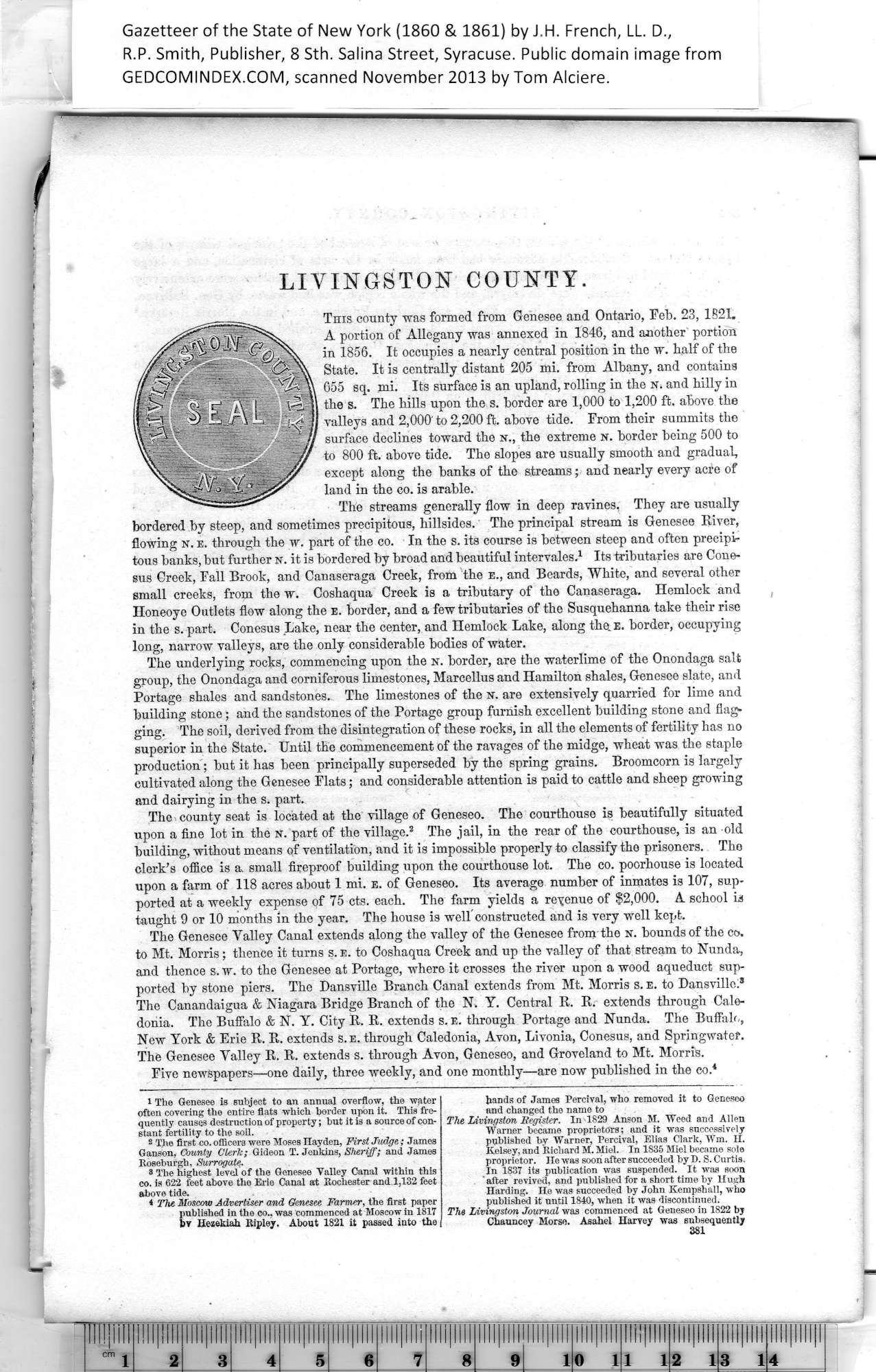|
LIVINGSTON COUNTY.
This county was formed from Genesee and Ontario, Feb. 23, 1821.
A portion of Allegany was annexed in 1846, and another portion
in 1856. It occupies a nearly central position in the w. half of the
State. It is centrally distant 205 mi. from Albany, and contains
655 sq. mi. Its surface is an upland, rolling in the n. and hilly in
the s. The hills upon the s. border are 1,000 to 1,200 ft. above the
valleys and 2,000' to 2,200 ft. above tide. From their summits the
surface declines toward the n,, the extreme n. border being 500 to
to 800 ft. above tide. The slopes are usually smooth and gradual,
except along the banks of the streams; and nearly every acre of
land in the co. is arable.
The streams generally flow in deep ravines, They are usually
bordered by steep, and sometimes precipitous, hillsides. The principal stream is Genesee River,
flowing n. e. through the w. part of the co. In the s. its course is between steep and often precipi¬
tous banks, but further sr. it is bordered by broad and beautiful intervales.1 Its tributaries are Cone-
sus Creek, Fall Brook, and Canaseraga Creek, from the e., and Beards, White, and several other
small creeks, from the w. Coshaqua Creek is a tributary of the Canaseraga. Hemlock and
Honeoye Outlets flow along the e. border, and a few tributaries of the Susquehanna take their rise
in the s. part. Conesus .Lake, near the center, and Hemlock Lake, along the. e. border, occupying
long, narrow valleys, are the only considerable bodies of water.
The underlying rocks, commencing upon the N. border, are the waterlime of the Onondaga salt
group, the Onondaga and corniferous limestones, Marcellus and Hamilton shales, Genesee slate, and
Portage shales and sandstones. The limestones of the N. are extensively quarried for lime and
building stone; and the sandstones of the Portage group furnish excellent building stone and flag¬
ging. The soil, derived from the disintegration of these rocks, in all the elements of fertility has no
superior in the State. Until the commencement of the ravages of the midge, wheat was the staple
production; but it has been principally superseded by the spring grains. Broomcorn is largely
cultivated along the Genesee Flats; and considerable attention is paid to cattle and sheep growing
and dairying in the s. part.
The county seat is located at the village of Geneseo. The courthouse is beautifully situated
upon a fine lot in the n. part of the village.2 The jail, in the rear of the courthouse, is an old
building, without means of ventilation, and it is impossible properly to classify the prisoners. Tho
clerk’s office is a. small fireproof building upon the courthouse lot. The co. poorhouse is located
upon a farm of 118 acres about 1 mi. e. of Geneseo. Its average number of inmates is 107, sup¬
ported at a weekly expense of 75 cts. each. The farm yields a reyenue of $2,000. A school is
taught 9 or 10 months in the year. The house is well'constructed and is very well kept.
The Genesee Valley Canal extends along the valley of the Genesee from the n. bounds of the co.
to Mt. Morris; thence it turns s. e. to Coshaqua Creek and up the valley of that stream to Nunda,
and thence s. w. to the Genesee at Portage, where it crosses the river upon a wood aqueduct sup¬
ported by stone piers. The Dansville Branch Canal extends from Mt. Morris s. e. to Dansville.3
The Canandaigua & Niagara Bridge Branch of the N. Y. Central R. R. extends through Cale¬
donia. The Buffalo & N. Y. City R. R. extends s. E. through Portage and Nunda. The Buffalo,
New York & Erie R. R. extends s.e. through Caledonia, Avon, Livonia, Conesus, and Springwatef.
The Genesee Valley R. R. extends s. through Avon, Geneseo, and Groveland to Mt. Morris.
Five newspapers—one daily, three weekly, and one monthly—are now published in the co.4
|
hands of James Percival, who removed it to Geneseo
and changed the name to
The Livingston Register. In 1829 Anson M. Weed and Allen
Warner became proprietors; and it was successively
published by Warner, Percival, Elias Clark, Wm. II.
Kelsey, and Richard M. Miel. In 1835 Miel became sole
proprietor. He was soon after succeeded by D. S. Curtis.
In 1837 its publication was suspended. It was soon
after revived, and published for a short time by Hugh
Harding. He was succeeded by John Kempshall, who
published it until 1840, when it was discontinued.
The Livingston Journal was commenced at Geneseo in 1822 by
Chauncey Morse. Asahel Harvey was subsequently
381 |
1
The Genesee is subject to an annual overflow, the water
often covering the entire flats which border upon it. This fre¬
quently causes destruction of property; but it is a source of con¬
stant fertility to the soil.
2
The first co. officers were Moses Hayden, First Judge; James
3
< The Moscow Advertiser and Genesee. Farmer, the first paper
published in the co., was commenced at Moscow in 1817
bv Hezekiah Ripley. About 1821 it passed into the
4
Roseburgh, Surrogate.
|
